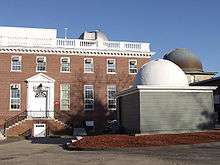Smithsonian Astrophysical Observatory

The Smithsonian Astrophysical Observatory (SAO) is a research institute of the Smithsonian Institution headquartered in Cambridge, Massachusetts, where it is joined with the Harvard College Observatory (HCO) to form the Harvard–Smithsonian Center for Astrophysics (CfA).
History
The SAO was founded in 1890 by Samuel Pierpont Langley, the Smithsonian's third Secretary, primarily for studies of the sun.[1] Langley is remembered today as an aeronautical pioneer, but he was trained as an astronomer and was the first American scientist to perceive "astrophysics" as a distinct field. Langley invented the bolometer and discovered infrared radiation from the sun.
In 1955, the SAO moved from Washington, D.C. to Cambridge, to affiliate with HCO and to expand its staff, facilities, and most importantly, its scientific scope. Fred Whipple, the first director of SAO in this new era, accepted a national challenge to create a worldwide satellite-tracking network, a decision that would establish SAO as a pioneer and leader in space science research.
Smithsonian and the USAF Project Space Track shared observations and ephemerides throughout the early days of satellite tracking, 1957–1961.
In 1973, the ties between Smithsonian and Harvard were strengthened and formalized by the creation of the joint Harvard-Smithsonian CfA.
Remote stations
SAO has operated a number of remote stations over the years.[2][3]
The SAO today
Currently, more than 300 scientists at the CfA are engaged in a broad program of research in astronomy, astrophysics, earth and space sciences, and science education.
SAO's pioneering efforts in the development of orbiting observatories and large ground-based telescopes, the application of computers to astrophysical problems, and the integration of laboratory measurements, theoretical astrophysics, and observations across the electromagnetic spectrum have contributed much to our current understanding of the universe.
The Chandra X-ray Observatory is managed and operated by SAO from Cambridge. With the University of Arizona, SAO also manages the MMT Observatory.
Directors
- Samuel Pierpont Langley 1890–1906[4]
- Charles Greeley Abbot 1906–1942[4]
- Loyal Blaine Aldrich 1942–1955[4]
- Fred Lawrence Whipple 1955–1973[4]
- George B. Field 1973–1982[4] (with the creation of the Harvard-Smithsonian Center for Astrophysics in 1973, the director of SAO and the Harvard College Observatory became a joint position)
- Irwin I. Shapiro 1982–2004[4]
- Charles R. Alcock 2004–[5]
References
- ↑ "SAO History". Retrieved 2015-09-03.
- ↑ Wright, F. W.; Hodge, P. W. (1965). "The Volcanic Dust Sampling Program of the Smithsonian Astrophysical Observing Stations". SAO Special Report #172 (1965). 172. Bibcode:1965SAOSR.172.....W.
- ↑ Roosen, Robert G.; Angione, Ronald J. (1977). "Variations in Atmospheric Water Vapor: Baseline Results from Smithsonian Observations". Publications of the Astronomical Society of the Pacific. 89: 814. Bibcode:1977PASP...89..814R. doi:10.1086/130233.
- 1 2 3 4 5 6 "SAO Directors: 1834 - Present". Smithsonian Astrophysical Observatory. Retrieved 2015-09-03.
- ↑ "Charles Alcock Named Director of the Harvard-Smithsonian Center for Astrophysics". Harvard-Smithsonian Center for Astrophysics. Retrieved 2015-09-17.
External links
Coordinates: 42°22′53″N 71°07′42″W / 42.38146°N 71.12837°W